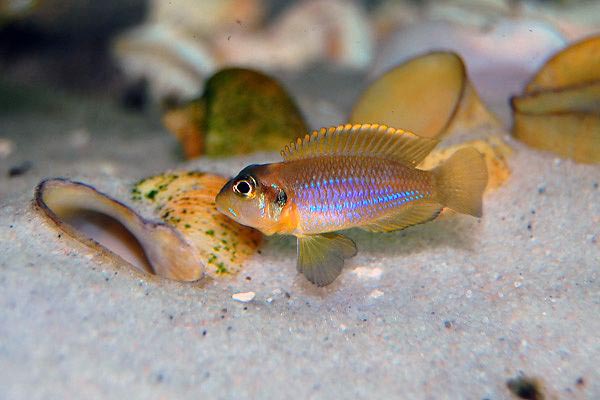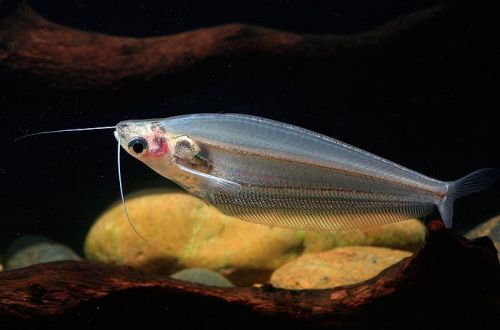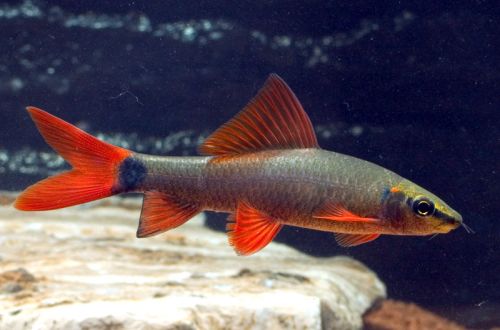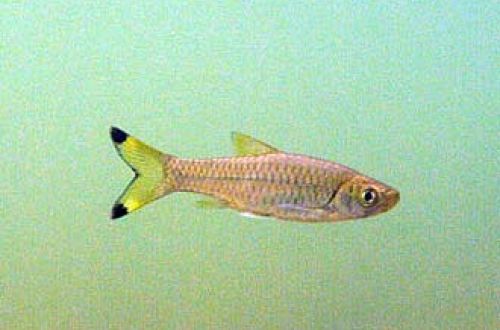
Lamprologus ocellatus
Lamprologus ocellatus, scientific name Lamprologus ocellatus, belongs to the Cichlidae family. Miniature bright fish. It is easy to keep and breed. Compatible with many species of comparable size provided there is sufficient space.

Contents
Habitat
Endemic to Lake Tanganyika in Africa, it is the second largest lake in the world. Located on the border of four states: the Democratic Republic of the Congo, Tanzania, Burundi and Zambia. This species is ubiquitous, preferring regions with sandy substrates along coastlines dotted with empty shells.
Brief information:
- The volume of the aquarium – from 40 liters.
- Temperature – 23-27°C
- Value pH — 7.5–9.0
- Water hardness – medium to high hardness (10-25 dGH)
- Substrate type – sandy
- Lighting – moderate
- Brackish water – no
- Water movement – weak, moderate
- The size of the fish is 3–6 cm.
- Food – any sinking food
- Temperament – conditionally peaceful
- Keeping in a pair of male / female or by type of harem
Description

Adult males reach a length of about 6 cm, females are much smaller – only 3 cm. The fish have a large head in comparison with the body and large eyes. They protrude above the head and for this unusual feature in appearance, the fish is sometimes called the “Frogfish”. The dorsal and anal fins are elongated, stretching from the abdomen to the base of the tail. The coloration is dominated by yellow shades, in males the scales on the sides of the body have blue tints, and on the fins there is a golden edging.
Food
In a home aquarium, it will accept sinking dry food rich in protein. It is recommended to include live or frozen foods such as brine shrimp and bloodworms in the diet.
Maintenance and care, arrangement of the aquarium
The optimal size of the aquarium for one pair of fish starts from 40 liters. In the design, it is necessary to provide for open sandy areas with a soil depth of at least 5 cm (the fish loves to dig in the sand) and many hollow snail shells. Lamprologus ocellatus uses them as hiding places and spawning grounds, in addition they are the center of their territory. The remaining elements of the decor are chosen at the discretion of the aquarist. The presence of plants is not required, but if desired, you can use. However, you should choose unpretentious species that can grow in hard and alkaline water.
When keeping, it is important to ensure stable water conditions with suitable pH and dGH values and avoid fluctuations in nitrogenous compounds (ammonia, nitrites, nitrates). Of key importance is a productive filtration system, regular cleaning of the aquarium from organic waste, weekly replacement of part of the water (10–15% of the volume) with fresh water.
Behavior and Compatibility
A territorial species that will protect its small area at the bottom from the encroachment of relatives and other fish. First of all, this applies to the male. In a small tank, it is recommended to keep only one male in the company of one or more females.
It is possible to combine with species that live in the water column or at the surface, such as Cyprichromis leptosome. In a spacious aquarium, it is acceptable to keep with other territorial fish (for example, Julidochromis), provided that there is enough space for the alpha males of each species.
Breeding / breeding
Shells play an important role in the reproduction of Lamprologus ocellatus, being a spawning site. Breeding is recommended to be carried out in a separate tank in the absence of other species – this significantly increases the chances of survival of the offspring. Unlike many other fish, females take the initiative in reproduction. With the onset of the mating season, they lay eggs each in their own shell and begin to invite the male. When they accept courtship, fertilization occurs. The females remain near the shell to protect the clutch. The male is no longer involved in caring for offspring.
The incubation period lasts about 3 days, after another 10 days the fry begin to swim freely and begin to move away from their shelter. When the juveniles reach a certain size, the female drives them out of the shell, and from that moment she is ready for a new stage of procreation.
Fish diseases
The main cause of most diseases of cichlids from Lake Tanganyika is unsuitable housing conditions and poor quality food, which often leads to such a disease as African bloat. If the first symptoms are detected, you should check the water parameters and the presence of high concentrations of hazardous substances (ammonia, nitrites, nitrates, etc.), if necessary, bring all indicators back to normal and only then proceed with treatment. Read more about symptoms and treatments in the Aquarium Fish Diseases section.





